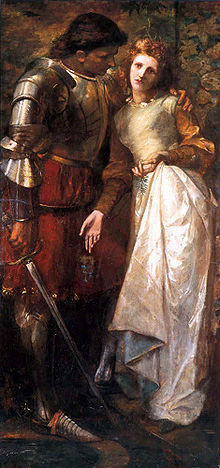
A sister complex (Japanese: シスターコンプレックス) is a state of strong attachment and obsession to one's sister or sisters. In Japanese, it is commonly abbreviated as "siscon" (シスコン),[1][2][3] in which case the term can also refer those brothers and sisters who feel a strong sense of affection or attachment to their sisters.
History
[edit]In 1917, Yoshihide Kubo stated in his work Psychoanalysis that Ophelia and Laertes had a "brother-sister complex" relationship.[4] In his 1932 work Psychological Analysis, Kubo called the father-daughter relationships arising from sexual instinct "father-daughter complex" and that between mother and son "mother-son complex". He argues that brother-sister complexes are transferences of the "father-daughter complex" and the "mother-son complex".[5]
The word "sister complex" was used in Hiroyuki Itsuki's novel Koiuta, which was serialized from October 12, 1967 to May 11, 1968.[6]
Overview
[edit]The term "sister complex" is wasei-eigo[2] and was originally a slang term for a related type of fetishism. However, in analytical psychology, the concepts of fetishism and complex are related, so the whole idea was generalized into the term "complex". If the other party is a brother, it is called a "brother complex".
The sister complex can be understood in the form of a brother who has "love feelings for his sisters" and an "exclusive desire to own them".[7][8] For men with a sister complex, older and younger sisters can become a target of sexual admiration, as well as idealized archetypes, to the point of being more influenced by them than by their parents. For instance, such men might choose a lover or spouse who is similar to or has something in common with his sister.[9] On the other hand, the term may also be used to describe women who are obsessed with sisters, in which case it is often seen relatively positively as "a woman who longs for her older sister" or "a woman who loves her younger sister".[citation needed]
Nobuhiko Obayashi described author Osamu Tezuka as having a sister complex, citing an episode in which Tezuka said, "There was nothing more erotic than having my younger sister drawing manga by my side." According to Obayashi, authors with a sister complex are characterized by the fact that they "do not grow roots in the ground", instead continuing to search for their lost "sister" while "jumping out of the earth and going to space or into the future." In addition, Obayashi states that they give up on sex when they realize that they can only love their sister. Obayashi mentions Akira Kurosawa, Howard Hawks, as well as Obayashi himself as examples of authors leaning towards a sister complex.[10][11] Yoshihiro Yonezawa cites Tezuka's sister complex as one of the qualities he couldn't show to other people.[12] Author Shotaro Ishinomori stated that he has a sister complex towards his older sister.[13][14] Naohiro Fumoto quoted the poems of Ono no Takamura and Ariwara no Narihira, who seemed to be attracted to their sisters, pointing out that they had a sister complex.[15] Fumoto also described Yukio Mishima in the same way, mentioning that Mishima had confessed that he loved his sister Mitsuko Hiraoka and that he also wrote works such as Tropical Tree which included incestuous themes.[16]
See also
[edit]References
[edit]- ^ Hodgkins, Crystalyn (January 3, 2014). "Sentai Filmworks Adds Engaged to the Unidentified Anime". Anime News Network. Retrieved January 1, 2021.
- ^ a b Akihiko Yonekawa, ed. (2003). 日本俗語大辞典. Tokyodo Shuppan. p. 267. ISBN 9784490106381.
- ^ Junji Yoshizaki, ed. (1986). 辞書にないことばの辞典. Nihon Bungeisha. p. 21. ISBN 9784537020182.
- ^ Yoshihide, Kubo (1917). 精神分析法. 心理学研究會出版部. p. 241.
- ^ Yoshihide, Kubo (1932). 精神分析学. 中文館書店. p. 225.
- ^ Hiroyuki Itsuki (1973). 五木寛之作品集. Vol. 12. Bungeishunjū. p. 50.
- ^ 用例でわかる カタカナ新語辞典 第3版学研辞典編集部, Gakken,July 2011,p. 256 ISBN 978-4053032645
- ^ Yokota, Masao (2016). 教養のトリセツ 心理学. Nihon Bungeisha. p. 123. ISBN 9784537261448.
- ^ きょうだいコンプレックス Takashi Okada, Gentosha,September 2015,pp. 173-174 ISBN 978-4344983915
- ^ Nobuhiko Obayashi (2008). ぼくの映画人生. Jitsugyo no Nihon Sha. p. 118. ISBN 9784408420110.
- ^ Nobuhiko Obayashi (2015). 大林宣彦の体験的仕事論. PHP Institute. pp. 246–248. ISBN 9784569825939.
- ^ Yoshihiro Yonezawa (2007). 手塚治虫マンガ論. Kawade Shobō Shinsha. p. 299. ISBN 9784309269597.
- ^ Shotaro Ishinomori (1998). 絆 不肖の息子から不肖の息子たちへ. NTT Publishing. p. 89. ISBN 9784757150089.
- ^ 漫画超進化論. Kawade Shobō Shinsha. 1989. p. 76. ISBN 9784309711751.
- ^ Masahiro Yamada; Naohiro Fumoto (2010). ダメ人間の日本史. Shakaihyoronsha. pp. 17–20. ISBN 9784784509775.
- ^ Masahiro Yamada; Naohiro Fumoto (2010). ダメ人間の日本史. Shakaihyoronsha. pp. 188–194. ISBN 9784784509775.